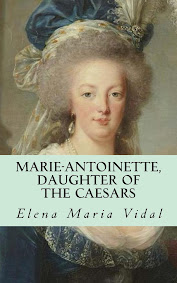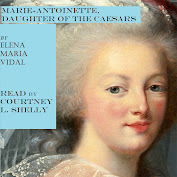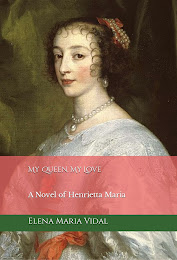I am honored to have had an article of mine recently published in the anthology Fellowship & Fairydust: Lives, Fortune, & Honor: An Early American Anthology, edited by Avellina Balestri. From the Amazon page:
The following is my article on Mary Land's Queen.
A portrait of Queen Henrietta Maria, wife of Charles I, for whom the state of Maryland is named, hangs in the Governor's Reception Room of the Maryland State House in Annapolis, the state capital. How an English colony like Maryland came to be named for a French Catholic princess is one of those flukes of history which no one could have foreseen or imagined, and which even today seems more like the whisper of a fairy tale than a cold fact of history.
Half-Bourbon and half-Medici, the life of Henrietta Maria of France (1609-1669) was turbulent from the beginning. Her father, the famous Henri IV, was assassinated when she was an infant. Henri IV or Henri of Navarre has been celebrated by the French people as the monarch who was the epitome of justice, kindness, and virility. The fact of his many mistresses and bastards never hindered his popularity, so great were his achievements on behalf of the French people in ending the Wars of Religion. His childless first marriage with his cousin Marguerite de Valois was annulled so that he could have legitimate offspring. He married the much younger and extremely wealthy and beautiful Italian princess Maria de' Medici in 1600. Queen Marie was devoutly Catholic and, loving her husband, suffered from his unfaithfulness. After she bore several children, Henri had Marie crowned at Notre Dame de Paris. The day after her coronation in 1610, Henri was assassinated. Marie became the Regent for her young son, Louis XIII.
Queen Marie is often dismissed as being "stupid" in histories of the time. Henri IV would never have designated Marie to be regent in case of his death if he had thought her hopelessly ignorant and helpless. Queen Marie had great devotion to the Virgin Mary, seeing her role as being like that of the Mother of God, the conduit of power between the king and his people. Her older daughters, Elisabeth, Queen of Spain and Christine, Duchess of Savoy, had been brought up with Marian devotion and saw their roles in their adopted countries as being active rather than passive. Henrietta Maria would tackle the insurmountable task of converting the British Isles back to Catholicism in the same light. As Regent, Queen Marie chose to avoid war by making peace with the other Catholic powers of Spain and the Empire. She believed that Catholic monarchies should unite to keep Protestantism at bay. In her later years, a falling-out with her oldest son Louis XIII led to her exile and eventual death in penury in Germany.
At fifteen years old “Henriette-Marie” was sent to marry Charles Stuart, who was a decade or so older. Queen Marie arranged the marriage because she believed there was a chance of bringing Charles I into Catholicism. Henriette-Marie was mandated by both the Pope and her brother the King of France to convert the English back to Catholicism. Meanwhile, the Catholic Faith had long been outlawed in the British Isles, so as Queen she became the principal lawbreaker. The powerful Duke of Buckingham tried to thwart her influence with her husband. England had become known as a place where queens could lose their heads. After the initial clashing of faiths, cultures and personalities, her marriage to Charles became one of the most devoted in the history of royal matches, and was blessed with nine children.
How England became a place that was dangerous for Catholics is a topic about which volumes have been written. It started of course with Henry VIII’s break from Rome which formed the groundwork for his son Edward VI’s Protestant reform of the English church. Edward’s sister Mary I brought England back to Catholicism but in doing so she launched a fierce persecution of those Protestants who refused to reconcile with the Catholic Church. Henrietta Maria was called “Queen Mary” in England which unfortunately brought to the mind of many people the Queen who was labeled “Bloody Mary.”
When Henry VIII’s youngest daughter Elizabeth I ascended the throne in 1558, she reversed her sister’s pro-Catholic policies and assumed the title and authority of Supreme Head of the Church in England. In 1570 Pope St. Pius V excommunicated her and declared in the bull Regnans in Excelsis that Elizabeth was not only a heretic but her subjects were released from their allegiance to her. It was then that Elizabeth began to actively persecute Catholics. One of her most famous victims was Mary Queen of Scots who, after almost twenty years imprisonment by Elizabeth, was accused of trying to escape and take the throne of England for herself. She was beheaded in 1587.When James I, the first Stuart king of England and son of Mary Queen of Scots, inherited the throne from his cousin Elizabeth, he maintained Elizabeth’s policies against Catholics. Catholics, who had been hoping for more freedom under James, were bitterly disappointed. On November 5, 1605 a group of Catholic conspirators centered around Guy Fawkes and Robert Catesby tried to blow up Westminster Palace when Parliament was meeting with the King. After what became known as the “Gunpowder Plot” Catholicism became viewed with disgust and fear by many English people. Sadly, this explains the hostility Henrietta Maria experienced when she came to England ready to lead everyone back to the Church of Rome.
During the troubles which led to the English Civil War, Henrietta Maria became a liability to Charles because of her religion and her meddling, both perceived and actual. But her courage and her devotion fueled the royalist cause, as she sold her jewels to raise money for arms, leading soldiers to aid her husband. While Charles I never converted to Catholicism, his relationship with his devout wife was deeply spiritual, which enhanced the intense physical passion between them. They were happiest together and with their children. Their tragedy is that they were eventually separated by the Civil Wars as their family was scattered. Their two youngest children were captives of the enemy forces. The family was never completely reunited in this world.
Because of Charles’ great devotion to his Queen, many in England feared that she would persuade him to become a Catholic. While he did not become one, he did give in to her pleadings on behalf of her co-religionists. When the Catholic Calvert family, headed by Lord Baltimore, applied for a royal charter to found a colony in America it was granted by King Charles on June 20, 1632. The new colony was to be named “Mary’s Land” in honor of Henrietta Maria. It was hoped that Catholics would have the freedom to practice their religion there. Accompanied by the Jesuit Father Andrew White, Leonard Calvert and two hundred and twenty other settlers sailed from England in two ships, the Ark and the Dove. They landed at St. Clement's Island in southern Maryland on March 25, 1634, the feast of the Annunciation. The first Catholic Mass in the original colonies was offered there.
What followed was one of the most peaceable colonial interactions with the Native Americans on record. Leonard Calvert bought land from the Yaocomico tribe, with whom the colonists became friendly. In 1639, after Fr. White healed the son of Chief Kittamaquund of the Piscataway tribe, the Chief and his family were baptized Catholic. The Chief took the name “Charles” in honor of Charles I, his wife was “Henrietta Maria” and their daughter became “Mary,” known in history as “Princess Mary of Maryland.” Mary was educated by Catholic settler Margaret Brent and married Margaret’s brother Giles Brent. Their descendants can be traced to the present day.
The first “sea” battle occurred in the Chesapeake Bay in 1638 between the Calverts and a Puritan named William Claiborne. Claiborne was trying to claim Kent Island for the Virginia Colony. Charles I, however, gave it to the Calverts as part of Maryland. In 1644, during the English Civil Wars, Claiborne led an uprising against the Calverts which eventually led to them being driven out of Maryland, while the penal laws of England were imposed on Catholic Marylanders. The Church had to go underground, which it did until American Independence was finally won in 1783. Meanwhile, St. Mary’s City, the original capital of Maryland, was burned by Claiborne and the capital was moved to a place called “Providence” but renamed “Annapolis” after Queen Anne, the Protestant granddaughter of Charles I and Henrietta Maria. So while Henrietta Maria’s plans for England were ultimately unsuccessful and her family was practically destroyed, she returned to England during the Restoration of her son Charles II to the throne. And one of the most beautiful states of the United States bears her name to this day.
Purchase the novel My Queen, My Love, HERE.
Purchase the anthology HERE.


















No comments:
Post a Comment